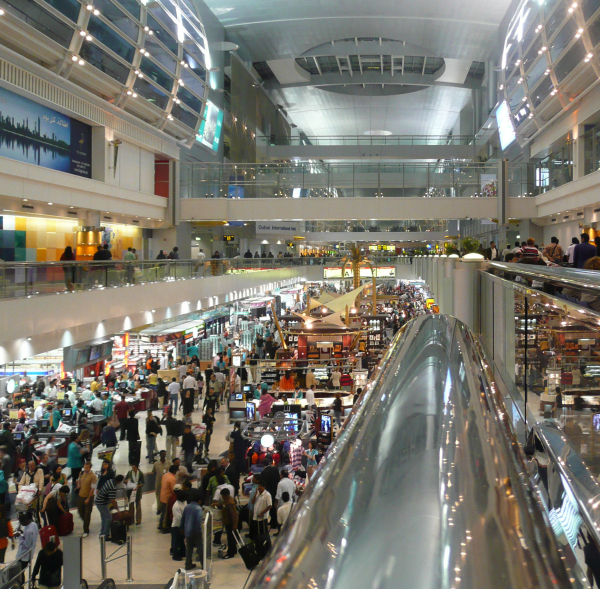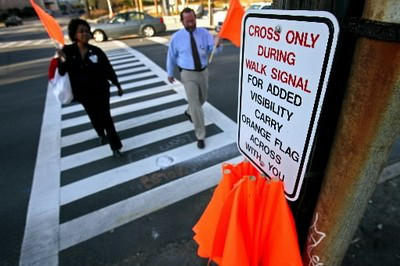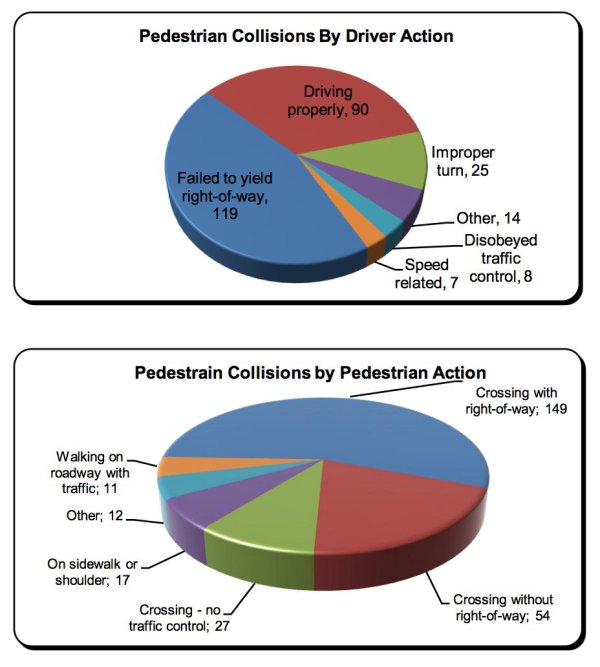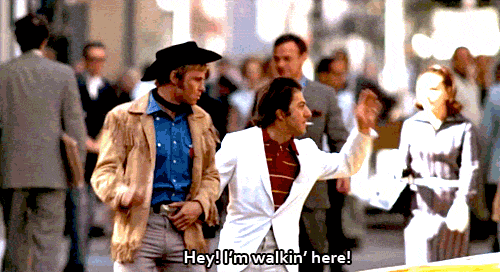'Shared responsibility' messaging ignores our basic human responsibilities - to look out for the more vulnerable among us.
By Justin Jones
Published May 02, 2016
Let me paint you a picture of a hypothetical situation.
I'm a large man - I'm over six feet tall, and nobody has ever mistaken me for a sprinter. Linebacker is a more apt comparison. So imagine that I'm in a crowded mall, maybe during the holiday rush. I've got a lot on my mind and on my plate - I'm trying to get all of my shopping done quickly so that I can go home and make dinner for my family.
I'm moving through the crowd at a brisk pace, passing slower-moving shoppers, my thoughts keenly trained on getting to the store where I know the last gift on my list is waiting.

A hypothetical mall where hypothetical me is shopping for hypothetical gifts
As I round the corner near the food court, a toddler, maybe 3 years old, makes a break from his mother - he's heading towards the mall Santa at considerable speed. As I'm walking past an older lady pushing a walker, the child, not looking where he is going, runs smack into the side of my right knee as it swings forward into the next stride. The boy is knocked down, and begins to cry.
Now in spite of the fact that it was the child that ran into me, that I was simply walking in a straight line and he ran directly into my path, I can guarantee you that it is me who apologizes in this situation. I certainly apologize to his mother, I make sure he's OK, and I generally feel awful about the whole situation.
In all likelihood, I should feel awful. In most instances, I'm alert enough and aware enough of my surroundings to preemptively see a runaway toddler and avoid that collision.
But in this case I was hurried and distracted, and I missed the cues. We all do this often, I'm sure. When we're in an area like a mall or an amusement park, we're hyper-aware of fast moving young people, and we take steps to avoid them colliding with us.
As larger, stronger individuals, we take it upon ourselves to make sure that our actions don't cause injury to a smaller, more vulnerable person. And that brings me to the point of this post: It seems as though that sense of duty and care that we all apply while we're walking up and vanishes when we get into a car.
Lately, there's been a barrage of messaging from various agencies, whether they be in Ontario or beyond, taking aim at the behaviours of people walking and cycling. From messages about wearing bright, reflective clothing to talking about the invented scourge of "distracted walking" to asking pedestrians to remove their earbuds while walking, much of the focus of these messages are on the behaviours of people walking.

Bright orange flags help keep full-grown people, who would otherwise apparently be invisible, 'safe'. Cross without this vital safety device at your own risk!
Now let's be clear - people do have a responsibility to look out for their own safety. I don't advocate wearing headphones, blaring loud music while playing Candy Crush on your phone and walking out into free-flowing traffic.
But to continuously shift the onus onto people walking by demonizing the very things that make walking so enjoyable - listening to music, staring up at the buildings, enjoying conversations and the sights and sounds of your environment, the ability to simply get up and go without needing to strap on lights, reflective safety vests and protective helmets, belies the fact that the vast majority of injuries to people walking occur because the person *driving didn't obey the law*.
They most often failed to yield the right of way at an intersection, although there are lots of other causes as well.

How collisions involving people driving and walking occur in Brampton, which happens to be in Peel Region.
One of the worst examples of this culture of victim-blaming I've seen to date came, unfortunately, from Peel Regional Police. During their "Pedestrian Safety Week", Peel Police offer such gems of advice like "Don't rely solely on traffic signals or stop signs. Ensure that it is safe to cross the road before crossing".
At the end of their list of advice, which includes the usual "wear reflective clothing", "cross at crosswalks" and other helpful tips, they offer one last piece of counsel, just in case there was any remaining doubt that their campaign has little interest in tackling the root cause of injuries to people walking - dangerous behaviours by people driving.
Peel Regional Police are urging pedestrians to be extra vigilant. Keep in mind that just because you have the right of way doesn't mean it is safe to utilize it.
Let that sink in for a second. Rather than running a campaign to encourage people driving to drive more attentively, to be extra careful of people walking and to always, as a default, yield the right of way to a more vulnerable road user, the police emphasize that, as someone who is not encased in a metal box, you need to be extra vigilant to protect yourself against those who would break the law and fail to yield the right of way, potentially endangering your life.

Hey! I'm walkin' here!
Asking people walking to remove their earphones ignores the fact that even with earphones in, you still hear more than a person in a car with their windows up.
Asking people to wear bright, reflective clothing ignores the fact that if a person driving can't see a large object "until it's too late", then they're arguably driving too fast for the light conditions or their own abilities.
Asking people to cross at crosswalks ignores the fact that there are many "signal crossing deserts" in modern urban environments, where safe crosswalks may be separated by a kilometre or more.
All of these asks serve the same purpose - to absolve those driving and those who design the systems where rapid movement of cars are prioritized, of their responsibility to plan for the more vulnerable.
When you're driving, speeding puts people at risk. Looking at your phone puts people at risk. Turning up the radio or fidgeting with your controls puts people at risk.
If you drive at a speed that allows you to react and prevent a collision and you keep all of your attention on the task of driving, you're planning for those more vulnerable - you're doing what I didn't do in the shopping mall example, watching constantly to make sure you don't get involved in a collision with someone more vulnerable than yourself.
When planners and engineers design roads for travel at 65-70 km/h through residential areas, when they space safe crossings far apart, when they fail to provide sidewalks or bike lanes or off-road trails, they're failing to plan for those more vulnerable populations as well.
One last point, before I offer my modified suggestions for pedestrian safety, and it's an important one.
A lot of these requests make it seem like it's hipsters looking down at their phones being injured or killed on the roads when they're out walking. Nothing could be further from the truth. When you look at the data for who dies while walking all across Ontario, one group stands out as dramatically over-represented: Seniors.
Take a look at this map of pedestrian fatalities in Toronto in 2016.
As of the writing of this post, 12 of the 15 deaths were people over 55 years old, with teh of the deaths being people over 65 years old. It's not young, healthy people making poor choices being killed on the roads while walking - it's predominantly grandparents and great grandparents moving slowly in dangerous areas.
So without further ado, I'll present my #PedestrianSafety Tips:
When driving, be sure to:
Constantly scan the roadway ahead, keeping a close eye for people walking. Especially in residential neighbourhoods, where children can be expected to be playing, keep your speed limited to 30km/h to maximize your response time and minimize the risk of death to people walking.
Maintain full attention on the task at hand. Inattention and distraction is now the leading cause of collisions in Ontario, so focus on the road ahead.
Yield the right-of-way when required by law. When in doubt, yield the right of way to people walking anyways. Their safety and ability to get home to their families is worth the extra few seconds of delay it may cause you.
If conditions are sub-optimal (rain, dark, snow etc), adjust your driving habits accordingly. Drive more slowly, and pay extra attention.
When walking, be sure to:
Remain attentive while continuing to enjoy the most basic and human form of movement.
Identify areas where safe crossings are required and call your community's traffic department, planning department and local councillors to let them know about the unsafe conditions.
Program your community's local law enforcement's non-emergency number into your phone and vigorously report any person driving who fails to yield the right of way.
Did I miss any tips? Send them to me on Twitter using the Hashtag #RealPedSafety!
This article was first published on Justin's website.
By japlanet (anonymous) | Posted May 02, 2016 at 07:24:20
Agreed. I was hit while crossing a side street as I walked eastbound on the southern side of Cannon. I was *in the intersection* before the car even appeared. The driver came to a rolling stop with his neck craned right (because cars are only approaching from the right, and what else could possibly be using the roads?), and then continued to move into me while I was literally standing directly in front of him. Luckily I was paying attention and was able to hop/run out of the way. The same thing would likely have happened were I on a bike on the Cannon St cycle track.
By KevinLove (registered) | Posted May 02, 2016 at 07:50:35
Program your community's local law enforcement's non-emergency number into your phone and vigorously report any person driving who fails to yield the right of way.
"Non-emergency number"? Sounds like an emergency to me. An emergency that poses a lethal threat. When I see this happen, I always call 911.
By ergopepsi (registered) | Posted May 02, 2016 at 08:41:23
"Don't rely solely on traffic signals or stop signs. Ensure that it is safe to cross the road before crossing" is probably some of the best advice police can provide. This is not 'victim blaming'. Don't get caught up in buzzwords as they can often cloud the reality that we all live with.
The most attentive and cautious drivers can make mistakes (or suffer a health emergency at the wheel) and when they do a red light/crosswalk/stop sign becomes meaningless. The one who pays for the honest mistake is the pedestrian or cyclist.
Just because it is the police ( I know I know, only uncool people listen to the cops ) giving the advice doesn't make it bad advice. Remember, these are the men and women who are first responders. They have, often horrible, first hand knowledge of what a traffic accident can do to a person and so have a vested interest in trying to prevent those accidents from happening.
By highasageorgiapine (registered) | Posted May 02, 2016 at 09:24:33 in reply to Comment 118092
this comment makes a point that i would like to expand on: health issues and driving. there is a great hesitancy from family physicians to remove drivers licenses from individuals with health issues that could impact their safety, and the safety of those around them, when driving. even something like poorly managed diabetes can result in a serious incident behind the wheel.
it's important to be vigilant when walking in high traffic areas. one way to mitigate the danger would be to design for slower, less voluminous traffic in the first place though.
By John Neary (registered) | Posted May 02, 2016 at 13:43:06 in reply to Comment 118094
As a general internist who cares for a lot of people with serious medical problems, I agree that medical fitness to drive is likely a contributing factor behind a meaningful proportion of road traffic accidents.
That being said, I do have a correction to make to one of your points:
there is a great hesitancy from family physicians to remove drivers licenses from individuals with health issues that could impact their safety
The relevant legislation is Section 203 of the Highway Traffic Act, which reads
Every legally qualified medical practitioner shall report to the Registrar the name, address and clinical condition of every person sixteen years of age or over attending upon a medical practitioner for medical services, who, in the opinion of such medical practitioner is suffering from a condition that may make it dangerous for such person to operate a motor vehicle.
That is, the physician does not remove the driver's license. He or she reports to the MTO that there is a condition that may make it dangerous for the person to operate a motor vehicle, and the MTO makes the final decision.
At least, that's how it is supposed to work. In real life, physicians are aware that they way in which they phrase their reports has great influence over what the MTO decides. The duty to report is not discretionary, and I think most physicians do take it seriously, although we're acutely aware of how much independence is lost in a car-dependent society when we do report concerns regarding fitness to drive and the MTO pulls the license.
There is room to improve the mechanism for reporting and follow-up, but more importantly, there is room to improve land use planning and transit service in order to allow people of all ages to be as independent as possible regardless of whether they can (or do) drive.
By highasageorgiapine (registered) | Posted May 02, 2016 at 09:19:59
i have very little to comment on here, aside from noting that this is an excellent article pointing out a serious problem. in hamilton i feel like i have my head on a swivel whenever i am walking along any main routes and still have occasional close calls. scary stuff.
I swear to God I thought that the "carry and orange flag" picture was a joke - either photoshopped, or a real-life "look what we have ALMOST come to" stunt. But a nagging doubt made me google it, just to be sure.
But it's real.
'For added visibility, carry orange flag across with you'
Summanabits.
Comment edited by moylek on 2016-05-02 10:06:39
You must be logged in to comment.
There are no upcoming events right now.
Why not post one?